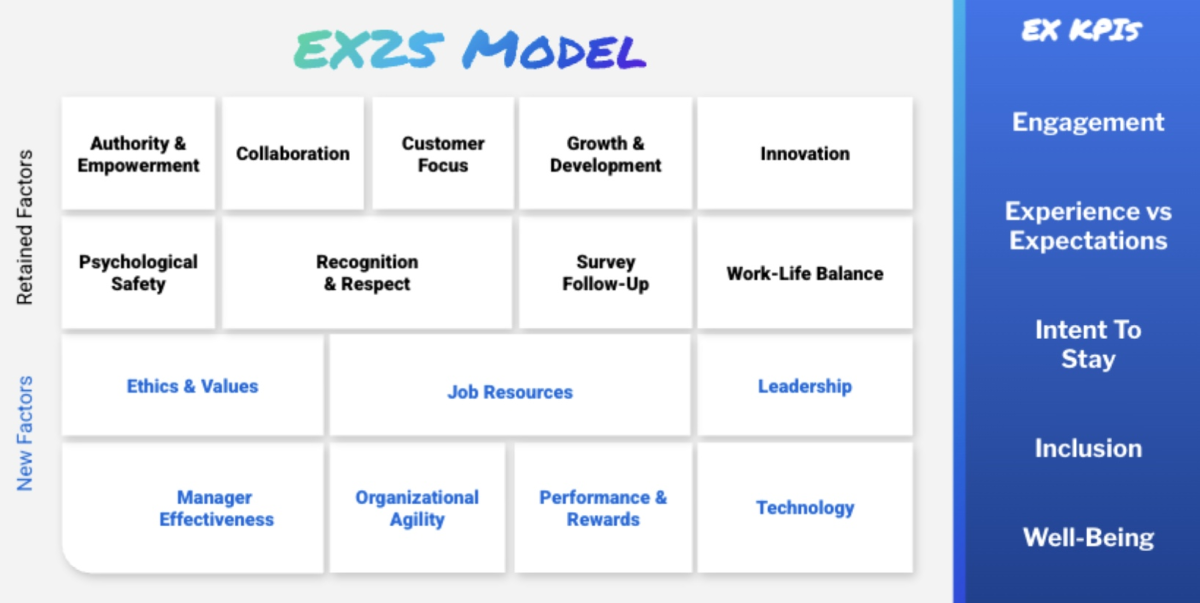The world of work is in an enduring period of disruption, forcing organizations to cope with ever-rapidly shifting business priorities and evolving employee expectations. Traditional employee listening programs, often centered solely on annual engagement surveys, are becoming stagnant, failing to keep pace with the complex modern workplace.
If your current approach leaves you struggling with survey fatigue and slow, unactionable data, it’s time to move beyond the old model.
The updated EX25 model is a scientifically validated, modern methodology designed to help organizations measure more of the employee experience with fewer questions, at an effective, yet realistic, cadence.
How to Measure Employee Experience Without Survey Fatigue
Organizations now must measure critical new areas alongside traditional engagement, including inclusion, well-being, collaboration, and organizational agility. However, attempting to measure more things more often carries a real risk of survey fatigue, which often occurs because surveys are too long, questions aren't relevant for frequent use, or managers receive results faster than they can truly act on them.
To solve this dilemma, Qualtrics leveraged the expertise of its in-house I/O psychologists and domain experts to develop the updated EX25 Model. This solution allows you to gather a holistic framework for measuring the employee experience that is short and highly actionable.
The model also includes seven new factors that reflect new topical workforce trends, such as technology - an especially critical trend as organizations navigate the impact of AI.

We have engineered our solution to measure five key Key Performance Indicators (KPIs) for the full employee experience, using the same number of items that most organizations use just to measure engagement.
Five critical KPIs for the modern workforce
Our scientifically validated methodology tracks five essential outcomes, giving you a comprehensive view of organizational health that goes far beyond simple job satisfaction:
From data to action: streamlined drivers and flexible listening
To ensure your results translate into meaningful business change, the original EX25 model’s dimensions have been rigorously analyzed and consolidated into 16 core driver categories. This streamlining provides focused, clear signals to guide organizational improvement.
The updated EX25 model introduces a flexible, tiered listening ecosystem that functions like a customized "health monitoring system":
- Diagnostic Survey (The Annual Check-up): A comprehensive instrument deployed annually to provide a robust baseline, deep driver analysis, and set broad strategic priorities using full 3-item KPIs and complete driver themes.
- Progress Survey (The Bi-Annual Follow-up): The ideal model for mid-year course corrections, offering sufficient depth and breadth to track key initiatives using robust 2-item KPIs and representative driver items.
- Check-In Survey (The Quarterly Temperature Check): Our most concise and tactical instrument, perfect for continuous feedback, tracking sentiment during periods of change, or empowering managers with frequent, lightweight, actionable data.
This flexibility allows organizations to tailor their approach - from a hybrid approach combining an annual baseline with quarterly pulses, to an agile approach favoring continuous quarterly check-ins.
Immediate action, measurable impact
Measurement is only the first step; the ultimate goal of employee experience feedback is improvement. The EX25 solution is fully integrated with a simple, yet powerful, action framework: Assess, Huddle, and Act (AHA):
- Assess: Managers review expert-designed dashboards to understand what the data is telling them, including identifying top drivers and focus areas where change will have the most positive impact.
- Huddle: Managers discuss results with their teams to co-create and agree upon new, improved working habits.
- Act: Teams adopt these new habits, creating meaningful, tactical change where it matters most - at the team level - and continuously track progress against the next survey pulse.
By focusing on the Percent Favorable (PFAV) metric, reporting is simple and universally understood: "What percentage of our people feel positive about this?". This aligns your internal reporting with external benchmarking standards and motivates leaders by focusing on the clear goal of increasing positive experiences.
The updated EX25 model moves your organization from measuring historical sentiment to proactively managing the employee journey. It’s the proven methodology to thrive in today’s disruptive environment by ensuring you have a realistic cadence for listening and the most actionable data.



